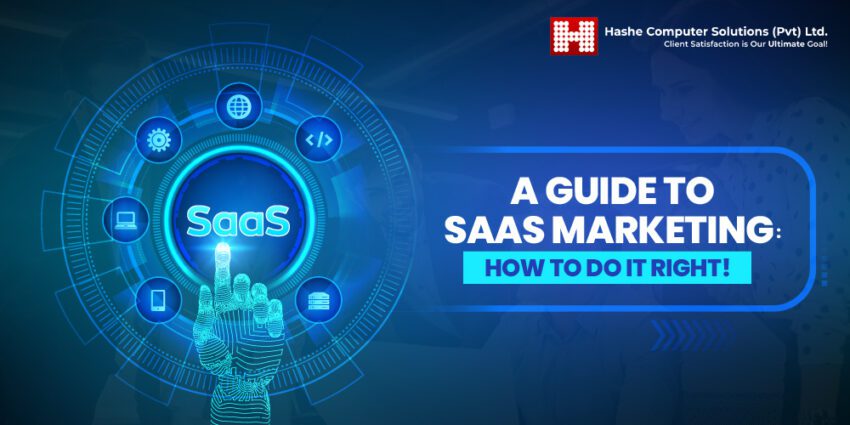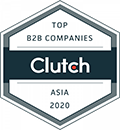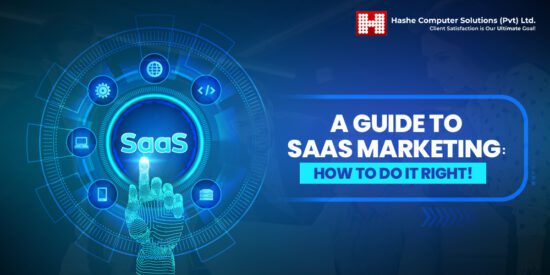
SaaS is everywhere, from the tools you use to manage projects, to the apps running your email campaigns, to the software helping you track expenses. But unlike traditional businesses, SaaS companies face a unique challenge: you are not selling a one-time product—you are selling ongoing value.
A flashy ad might get someone to sign up, but keeping them around for months or years requires a totally different approach. That’s where SaaS marketing comes in. It is not just about driving clicks or generating leads; it is about creating a seamless journey where potential customers discover your product, understand its value, and continue to see that value over time.
In contrast to traditional product marketing, which focuses on one-time sales, SaaS marketing seeks to persuade customers to continue using the program, extend their subscription, and gradually upgrade to a more expensive plan.
In this guide, we’ll break down what SaaS marketing really means, why it’s unique, and how to do it right.
What is SaaS Marketing?
SaaS Marketing is an acronym for Software as a Service marketing. Digitally promoting and creating leads for subscription-based software is the primary objective of this kind of marketing.
Typically cloud-based, this software is marketed as a simple solution for a company’s primary pain points. Since SaaS products are intangible, marketing them is usually more difficult. Customers must be regularly reminded of the value of the service through frequent upgrades and new features.
SaaS companies must convince customers to purchase their services or subscribe, and then provide a consistently positive experience. A successful SaaS marketing strategy involves delivering ongoing value, ensuring a smooth onboarding process, and promoting continuous client interaction.
For SaaS companies, a marketing plan goes beyond functionality. It presents your product as a solution to the actual problems it will solve and explains how it will change over time to satisfy consumer demands.
Why is SaaS Marketing Different from Traditional Marketing?
SaaS marketing may include strategies, such as content, SEO, and paid acquisition, similar to traditional digital marketing. However, the underlying approach is quite different.
You’re not merely promoting a one-time purchase or conversion. You are under constant pressure to demonstrate value, maintain high engagement, and lower churn because you are offering a product that users can cancel at any time.
Marketing in SaaS doesn’t stop after the sale. It continues to work with product, support, and success teams to convert signups into loyal customers.
The following table summarizes the key differences between Saas marketing and traditional digital marketing.
| Aspect | SaaS Marketing | Traditional Digital Marketing |
| Business Model | Subscription-based: users pay monthly/annual (recurring revenue) and can upgrade or downgrade anytime. | One-time purchase or transactional sales with occasional upsell/privacy resets. |
| Product Nature | Digital, intangible, complex: feature-heavy, often customizable | Physical or standalone |
| Customer Journey | Continuous (multi-stage) lifecycle: awareness → activation → retention → expansion. | Linear funnel: awareness → consideration → purchase. |
| Primary Goal | Long-term retention, reducing churn, maximizing lifetime value (CLV). | Driving immediate conversions or sales volume. |
| Sales Cycle | Often longer, especially for B2B (multiple stakeholders, demos, trials). | Usually shorter, focused on direct purchases. |
| Marketing Focus | Product-led growth, onboarding, customer success, community building. | Promotions, brand awareness, and customer acquisition. |
| Marketing Channels | Heavy on SEO, content, email nurture, paid acquisition, in-product prompts | Mix of paid ads, social, email; often includes offline like print or billboards |
| KPIs & Metrics | Recurring metrics: Churn rate, Net Revenue Retention (NRR), CLV, Customer Activation Rate, Customer Acquisition Cost (CAC) | Campaign metrics: Click-through rate (CTR), impressions, ROI, cost per sale, conversion. |
| Customer Relationship | Ongoing value delivery; continuous engagement needed. | Transactional; limited engagement after purchase. |
| Content Strategy | Heavy focus on education: blogs, tutorials, webinars, comparison pages. | Promotional content: ads, discounts, product features. |
| Revenue Growth | Expansion through upselling, cross-selling, and reducing churn. | Growth mainly from acquiring new customers. |
| Risk of Loss | High churn risk if value isn’t proven quickly. | Low risk post-purchase (once the product is sold). |
| Pricing Structure | Tiered/subscription with freemium, usage-based, seat-based and enterprise plans | Usually fixed-price or one-time with little flexibility |
Saas Marketing Strategies to Grow Your Business
Share Valuable Content
Posting content that establishes your expertise in your subject is essential if you want to attract the right users. Consider your website a place where your consumers can discover solutions to their most pressing questions.
Providing real value is more important than just publishing blog posts. That said, each blog article should provide value to the customers. Post tips that your audience can’t get anywhere other than your website. These could include in-depth case studies, comprehensive guides, professional counsel, and practical assistance.
You can post the following:
- Blog Posts: Discuss practical issues that your software can resolve.
- Case Studies: Tell success stories that demonstrate the worth of your software.
- Industry Reports: Display trends and insights in your sector with statistics.
- eBooks and whitepapers: Provide comprehensive materials that establish your company as an authority.
- How-To Guides: Provide detailed instructions to help users maximize their experience with your product.
The objective is to establish yourself as an industry expert. Prospective buyers are more inclined to trust your product and stick with it if they perceive that you genuinely understand their issues.
Create Engaging Videos
Did you know? According to Wyzowl, 78% of buyers would rather watch a video than read about the product. The reason for this is that videos enable you to swiftly explain complicated ideas and help customers understand the benefits of your program. Videos are an excellent way to connect with potential clients and maintain their attention in SaaS marketing.
Videos make complex features easier to understand, build confidence by showing real-world instances of usage, and significantly increase conversion rates by demonstrating to potential customers the value of your product. Incorporate these videos into emails, your website, and social media to increase exposure and conversions.
You can make videos like:
- Product demos: Illustrate how your software addresses actual issues.
- Customer Testimonials: Share genuine feedback from satisfied customers.
- How-To Videos: Walk users through common tasks or installation procedures.
- Highlights of the Features: To keep the audience engaged, post notices of updates or new features.
Be Active on Social Media
Social media is an effective SaaS marketing tool. It facilitates connecting with potential customers, expanding your audience, and increasing brand recognition. You may post helpful content, respond to consumer inquiries, and highlight the advantages of your product by being active on social media sites like Facebook, LinkedIn, and Twitter.
Social media enables you to share customer success stories, showcase product benefits, and interact with your audience. You can participate in discussions within your niche, establish your brand as a thought leader, and inform your followers of new features or exclusive deals.
You can maximize the benefit of social media by:
- Posting regularly: Post user success stories, product updates, and tips.
- Engaging with followers: Responding to messages and comments helps boost trust.
- Using trends and hashtags: Participate in relevant discussions to broaden your audience.
Focus on Helping First
A common mistake that SaaS marketers make is selling too quickly. Everyone wants real answers to their problems; no one wants to be pressured into a transaction.
Provide your audience with real value rather than just talking about selling. Give your users practical guidance, free resources, and professional advice that will genuinely benefit your prospective clients. It enhances your brand’s value, fosters trust, and demonstrates your understanding of their problems. Putting your audience’s needs first makes it easier to sell because they already view you as a reliable source.
Helping first leads to:
- More satisfied customers
- Stronger brand loyalty
- Higher conversion rates
- Lower customer churn
- Positive word-of-mouth referrals
Concentrate on Organic Search
One of the least expensive strategies for attracting consistent, long-term customers to your SaaS product is organic search. In contrast to sponsored advertisements, which truncate their results as soon as your budget runs out, organic search does not. You may reduce customer acquisition expenses, build brand authority, and attract high-intent prospects with the right SEO strategy.
You can obtain consistent, high-quality traffic without always paying for clicks with organic search. The following organic search components are crucial for your SaaS marketing strategy.
- Keyword research: Find out what terms your target market is searching for. Use tools like Ahrefs or Semrush to find low-competition, high-traffic keywords.
- On-page SEO: To improve your website’s search engine ranking, optimize its content, meta tags, headers, and URLs.
- Content marketing: Create high-quality blog posts, manuals, and case studies that address the problems of your clients.
- Backlink Development: To raise your domain authority, obtain high-quality backlinks from reputable websites.
- Technical SEO: Improve website speed, fix internal linkage problems, and apply appropriate internal linking to improve user experience and search engine ranking.
Invest in Online Ads
Reaching prospects organically is only one aspect of marketing. Ensuring you’re visible wherever your potential clients spend their time is essential when marketing software.
While organic traffic is best for long-term growth, paid ads can give your SaaS marketing strategy a boost right away. Targeted internet advertising enables you to rapidly reach a specific demographic, making it perfect for promoting new features and special deals, or driving visitors to your landing pages.
If done strategically, placing online ads is a powerful way to raise sales, generate leads, and increase brand awareness. The following can help boost your SaaS marketing initiative.
- Google Search Ads: Leverage search ads to reach users who are actively searching for services similar to yours. This way, you can find high-intent buyers.
- Social media ads: You can target specific individuals by industry, job, or interests on social media sites like Facebook, Instagram, and LinkedIn.
- Retargeting: Bring back visitors who visited your website but did not sign up or convert by showing them targeted ads.
- A/B testing: Be sure to test several iterations of your calls to action, images, and ad copy.
- Track and Optimize: Track performance using your analytics. To boost your return on investment (ROI), regularly assess and enhance your campaigns by identifying what strategies are effective.
Send Personalized Messages
In SaaS marketing, sending personalized messages is a great way to build real customer relationships. Make a personal connection with potential clients by sending them tailored emails, direct messages on social media, or targeted LinkedIn direct messages.
It is effective since personal messages make people feel valued straight away. The response rates are significantly higher, which frequently results in faster conversions.
Now that we know personalization helps boost SaaS marketing initiatives, let us see where to start.
- Welcome Emails: When someone signs up, sending a personalized email to them immediately makes them feel welcome.
- Follow-up messages: Follow up with leads directly who expressed interest but did not become customers. Encourage them or extend assistance.
- Client Milestones: Celebrate with users when they reach significant milestones, such as reaching a utilization goal, finishing their setup, or using the product regularly for a certain number of months.
- Product Suggestions: Recommend features or add-ons, depending on user behavior.
- Birthday or anniversary messages: Personalize your message with exclusive deals and offers on significant occasions.
Target Specific Companies
Concentrating your efforts on particular businesses that are a perfect fit for your clientele works better when using B2B SaaS. It is called Account-Based Marketing (ABM). The primary role of this strategic approach is to focus on specific, high-value accounts. It helps reduce the sales cycle time and connect with high-value clients.
The benefits of concentrating on specific businesses include higher conversion rates, deeper client connections, and more consistent revenue.
Here’s how you can start with account-based marketing:
- Create a List of Your Target Accounts: Determine companies that will benefit most from your software. Choose the ones that most closely resemble your ideal client profile.
- Personalize Your Outreach: Avoid sending clichéd messages. Make sure that any correspondence, whether via email, LinkedIn, or direct mail, is tailored to the particular requirements, challenges, and objectives of that business.
- Utilize LinkedIn and Social Media: Actively interact with decision-makers and influencers at the companies you’re pursuing. Engaging with their posts directly and sharing stuff that is truly valuable fosters connections.
- Provide Free Trials or Custom Demos: Avoid providing generic walkthroughs. Offer individualized trials or demos that aim at each target account’s unique pain points.
- Employ targeted retargeting ads: Keep your brand in front of major decision-makers by retargeting ads.
Ask Satisfied Customers to Spread the Word
Word-of-mouth advertising is one of the most effective SaaS marketing strategies. Peer referrals are often more trusted than advertisements or sales pitches. Your users will become your finest marketing team if they are satisfied.
Positive testimonials from satisfied clients increase confidence and attract quality leads that are more likely to become customers.
You can encourage your satisfied customers to spread the word by:
- Referral programs: Offer incentives to everyone who brings in new clients. You can offer discounts, credits, or special access to features. Ensure that they have a compelling motive to share.
- Testimonials & Reviews: Don’t hesitate to ask satisfied clients to write about their experiences. Ask them to post on review platforms.
- Social Proof: Share the user success stories by posting them on your social media accounts and website.
- Customer Stories: Describe everything in detail. Publish real-life case studies that demonstrate the impact of your software.
- User-Generated Content: Encourage people to share their own successes. Urge people to share their own success stories or outcomes on the internet.
Offer Free Trials
Offering a free trial or a freemium edition is one of the most effective ways to attract new SaaS consumers, which eliminates the initial risk. It enables prospective buyers to fully test the worth of your product before committing to a premium plan.
To truly succeed with this approach, employ tailored follow-ups, provide excellent onboarding assistance, and be transparent about trial durations. In this way, you convert those free users into paying clients.
How to Measure the Success of your SaaS Marketing?
Tracking significant data that shows the expansion of your company and the health of your clientele will help you determine whether your SaaS marketing efforts are succeeding. The most crucial metrics are as follows:
Website Traffic
Examine your traffic volume, as well as your conversion and bounce rates. A high bounce rate can indicate that visitors aren’t finding your page helpful or that the navigation on your website is confusing. You can increase incoming revenue by identifying and fixing the issue.
Identify the top-performing posts using Google Analytics that will help you generate audience-valued content. Additionally, you’ll be able to discover any problems with your SEO plan.
Brand Search Volume
One excellent SaaS measure for assessing brand awareness is brand search volume. It is computed based on the number of visits to your website from search engines using branded keywords.
By putting your brand name in meta descriptions, bidding on your branded keywords, and appending your brand name to the end of blog titles, you can gain an advantage in branded search.
Use this information to discover how people find your brand and identify the opportunities to increase search volume. Remember to evaluate the amount of brand searches compared to those of your competitors. You can then promptly identify and address branded gaps.
Product Page Entrances
Similar to website traffic, tracking product page traffic is crucial for ensuring you are providing customers with a positive user experience. Provide prospective clients with the information they need on your website.
It is ideal to evaluate entrances in conjunction with branded clicks and time on page to assess the precision of your messaging and the usability of each page.
Over time, you’ll probably discover that your product pages require constant improvement to draw in target clients and achieve your marketing objectives.
Number of Conversions
Conversion rates are a metric that measures user engagement and marketing performance. It examines how many consumers accessed your SaaS marketing funnel, engaged with your campaign, and completed the desired action before becoming a customer.
Throughout your sales funnel, you want to track conversions. Examine the quantity of leads at every touchpoint. This allows you to detect potential problems in the user journey and make necessary adjustments for your future campaign.
Quality of Your Leads
Checking the quality of your leads will tell you if you are targeting your ideal customer profile.
Unqualified leads will only prevent your SDRs (sales development representatives) from achieving their sales goals and waste the work of your SaaS marketing team. Try using lead scoring to differentiate between high-quality leads and low-quality ones, so you don’t waste time on unqualified prospects.
Cost Per Lead (CPL)
Cost per lead (CPL) helps identify the channels yielding the most leads. Moreover, you can determine how effectively you are honing your social media targeting and the amount of money you can spend on obtaining new leads.
Customer Lifetime Value (CLV)
The CLV metric measures the total revenue a client will bring in throughout the course of your business partnership. It helps you identify the channels to focus on for content marketing and the budget for your annual SaaS marketing plan.
Customer Acquisition Cost (CAC)
Customer acquisition cost is a critical indicator for assessing the effectiveness of your marketing initiatives.
You should aim for the lowest CAC feasible, especially if you’re presenting this revenue data to your board. Additionally, your CAC will guarantee that you’re receiving a solid return on investment and help you keep within your SaaS marketing budget.
Monthly Recurring Revenue (MRR)
MRR is the monthly predictable revenue generated by your SaaS company. It’s a crucial indicator for monitoring financial stability and growth.
Customer Churn
Customer churn is the rate of clients who decide to end their contracts with your business. Since keeping existing customers is significantly less expensive than finding new ones, it’s a crucial indicator for SaaS growth marketing.
You will want to keep your client churn as low as possible. Always ask your existing clients how you might enhance their experience.
Wrapping Up!
Understanding your audience, creating a devoted user base, generating recurring revenue, and establishing long-lasting customer connections are the main goals of SaaS marketing.
Long-term growth requires not only acquiring more leads but also keeping them. From selecting the best digital platforms to establishing precise company objectives, every action is a step closer to acquiring and retaining clients.
However, offering genuine value and maintaining user engagement are crucial, regardless of whether you’re concentrating on paid advertising, content marketing, or customer referrals.
Are you looking for the best IT providers for your IT projects? Look no further than Hashe! Hashe Computer Solutions is a leading IT solutions provider that offers world-class software, mobile application, web development, and digital marketing services. Contact us for the best web design and Digital Marketing solutions!
Was this helpful?
Last Modified: August 28, 2025 at 12:17 pm
15 views















